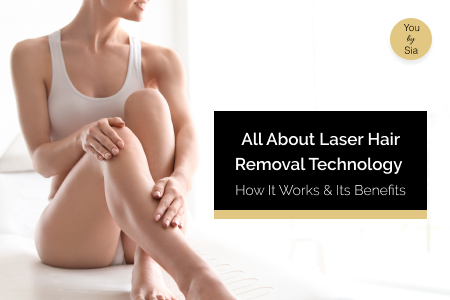Everything You Need to Know About Laser Hair Removal Technology: How It Works and Its Benefits
In a world where smooth skin often signifies confidence and beauty, the demand for effective hair removal solutions continues to rise. As more people seek alternatives to the never-ending cycle of shaving and waxing, laser technology has emerged as a standout option for long-term hair reduction.
No more razor burns, ingrown hairs, or the hassle of constant upkeep—laser hair removal offers a lasting, precise, and convenient alternative. Whether you want to save time in your routine or simply seek a more permanent solution to unwanted hair, laser hair removal has quickly become the go-to choice for those prioritising efficiency and effectiveness in their grooming practices.
As this technology continues to evolve, understanding its benefits and mechanisms is essential for anyone considering it as a viable option in their self-care regimen. In this blog, we will explore how laser hair removal works and its key benefits, helping you determine if it’s the right choice for your grooming needs.
How Laser Hair Removal Works
Laser hair removal uses concentrated light beams to target hair follicles while leaving the surrounding skin unharmed. The procedure relies on the principle of selective photothermolysis, where the laser's energy is absorbed by melanin, the pigment in hair that gives it color. When melanin absorbs the laser light, it converts it to heat, damaging the hair follicle and inhibiting its ability to produce new hair.
The effectiveness of laser hair removal largely depends on the hair growth cycle, which consists of three main phases: anagen, catagen, and telogen. The anagen phase is the active growth stage when hair is firmly rooted in the follicle, making it the most effective time for laser treatment. In contrast, the catagen phase is a transitional stage where hair stops growing and begins to shrink, while the telogen phase is a resting stage where the hair is shed and the follicle is dormant.
To achieve optimal results, multiple laser hair removal sessions are necessary, as not all hair is in the same phase at any given time. Treatments are typically spaced several weeks apart, allowing hair to progress into the anagen phase. This staggered approach ensures that as many follicles as possible are targeted when they are most responsive to the laser treatment.
Modern lasers can effectively target lighter hair shades and work on various skin types, although individuals with darker hair and lighter skin generally see the best results. Understanding these dynamics can help potential patients determine whether laser hair removal is the right choice for them.
Types of Laser Technologies
Different laser technologies are used in hair removal, each suited to specific skin tones and hair types. Understanding these technologies can help you choose the most effective option.
Soprano Titanium Technology
Soprano Titanium is an advanced laser technology that is painless and efficient, making it popular for those with lighter skin tones. It uses a combination of wavelengths to target the hair follicles while cooling the skin, minimising discomfort during the procedure.
One of its main benefits is the ability to treat larger areas quickly. However, it is generally less effective on darker skin tones due to the risk of melanin absorption by the skin, which can lead to pigmentation issues.
Diode Laser
The diode laser is one of the most versatile technologies and is suitable for a wide range of skin types, from light to medium-dark tones. It emits a longer wavelength of light, penetrating deeper into the skin to target the hair follicle without impairing the surrounding tissue.
This makes it highly effective for hair reduction, especially in people with coarse or thicker hair. The diode laser is considered safe and effective for many skin types but may require more sessions for optimal results on lighter or very fine hair.
Nd Laser
The Nd Laser is designed specifically for darker skin tones. It operates at a wavelength that allows the laser to bypass melanin in the skin and focus directly on the hair follicles. This reduces the risk of skin damage, making it the safest option for people with higher melanin levels. While it is excellent for darker skin, it may be less effective on lighter hair colours due to the limited amount of melanin in the hair itself.
Step-by-Step Process of Laser Hair Removal
Step 1: Consultation and Skin Assessment: The process begins with a thorough consultation and skin assessment. During this initial appointment, a qualified practitioner evaluates your skin type, hair colour, and medical history to determine your suitability for laser hair removal. This assessment helps in choosing the right laser technology for optimal results while minimising any potential risks.
Step 2: Preparing the Treatment Area: The treatment area must be properly prepared before the procedure. This involves shaving the hair to ensure the laser targets the hair follicle directly. Avoid waxing or plucking in the weeks leading up to the treatment, as these methods can remove the hair from the follicle, making the laser less effective.
Step 3: The Laser Session: The practitioner uses a handheld laser device to target the hair follicles during the laser session. You may experience a mild sensation. Most modern devices also incorporate cooling features to minimise discomfort. The length of the session depends on the size of the treatment area, ranging from a few minutes for small areas to over an hour for larger ones.
Step 4: Aftercare: Post-treatment care is crucial for optimal results. After your session, avoid sun exposure and certain skincare products, such as retinoids and exfoliants, for at least a week. This helps reduce the risk of irritation and allows your skin to heal properly.
Key Benefits of Laser Hair Removal
Precision: Laser hair removal targets specific hair follicles without damaging the surrounding skin. This precision is particularly valuable for sensitive areas like the face and bikini line. Focusing solely on the hair reduces irritation and the risk of skin damage, ensuring smoother and safer results.
Effectiveness: One of the main reasons people choose laser hair removal is its effectiveness. Targeting the hair at the follicle disrupts the growth cycle, leading to significant long-term hair reduction. Multiple sessions are required, but many people see a permanent decrease in hair growth, making it a cost-effective alternative to shaving and waxing in the long run.
Minimal Downtime: Laser hair removal sessions are typically quick, with small areas taking just minutes and larger areas around an hour. There is little to no recovery time, allowing you to return to daily activities immediately after treatment. This minimal downtime is ideal for those with busy schedules who want to avoid lengthy recovery periods.
Versatility: This treatment is highly versatile and suitable for various body areas, from small zones like the upper lip to large sections like the legs. With advancements in laser technology, it works well for various skin tones and hair types, making it accessible to more people than ever before.
Potential Side Effects of Laser Hair Removal
While laser hair removal is generally safe and effective, there are potential side effects, most of which are mild and temporary. Understanding these risks can help you manage expectations and ensure proper aftercare.
Common Side Effects
Redness: Mild redness in the treated area, resembling a sunburn.
Swelling: Temporary swelling around the hair follicles.
Skin Irritation: Slight discomfort or tingling sensation, which subsides within a few hours or days.
Rare Side Effects
Pigmentation Changes: Hyperpigmentation (darkening) or hypopigmentation (lightening) of the skin, especially in those with darker skin tones.
Blistering: Small blisters can form if the skin reacts strongly to the laser.
Scarring: Rare but possible, particularly if the skin is not cared for properly post-treatment.
How to Minimise Risks
Avoid Sun Exposure: Protect the treated area from the sun for at least a week post-treatment. Use a high-SPF sunscreen.
Skip Harsh Products: Avoid using retinoids, exfoliants, and other strong skincare products on the treated area.
Keep Skin Moisturised: Apply soothing creams and moisturisers as your dermatologist recommends.
Choose a Qualified Practitioner: Ensure your treatment is performed by a licensed and experienced professional to minimise risks.
Conclusion
Laser hair removal offers a convenient, effective, and long-lasting solution for those seeking to reduce unwanted hair. Its precision, versatility, and minimal downtime make it a compelling choice for many. While it’s important to consider factors like skin tone and hair type, advancements in laser technology have expanded its accessibility to a wider range of individuals.
If you’re ready to invest in smoother, hair-free skin, laser hair removal is a promising option. At You By Sia, we offer cutting-edge laser treatments tailored to your unique skin and hair type. Call us at 02 8806 0395 to schedule a consultation and discover how laser hair removal can provide you with smoother skin in the long term.



